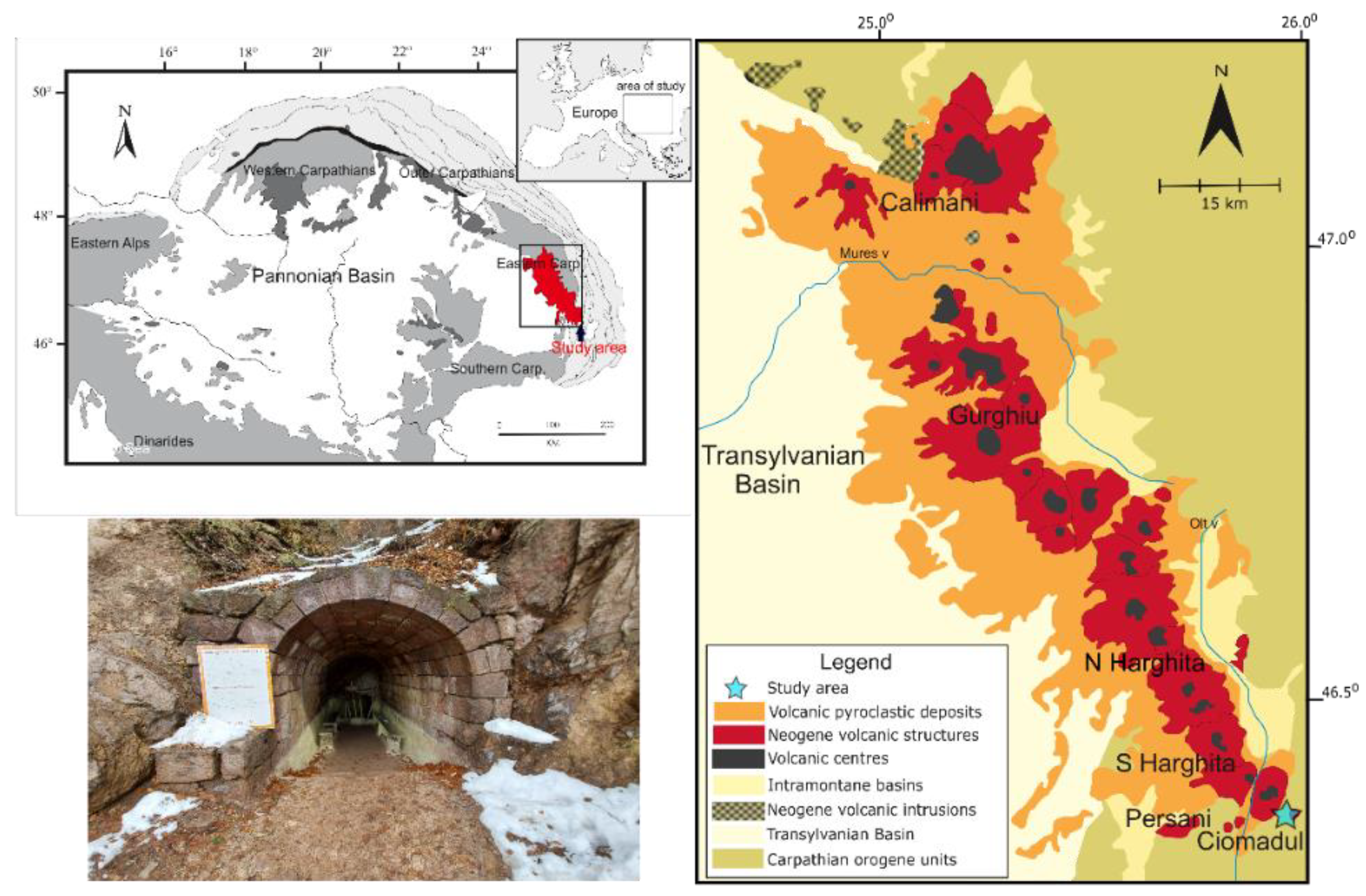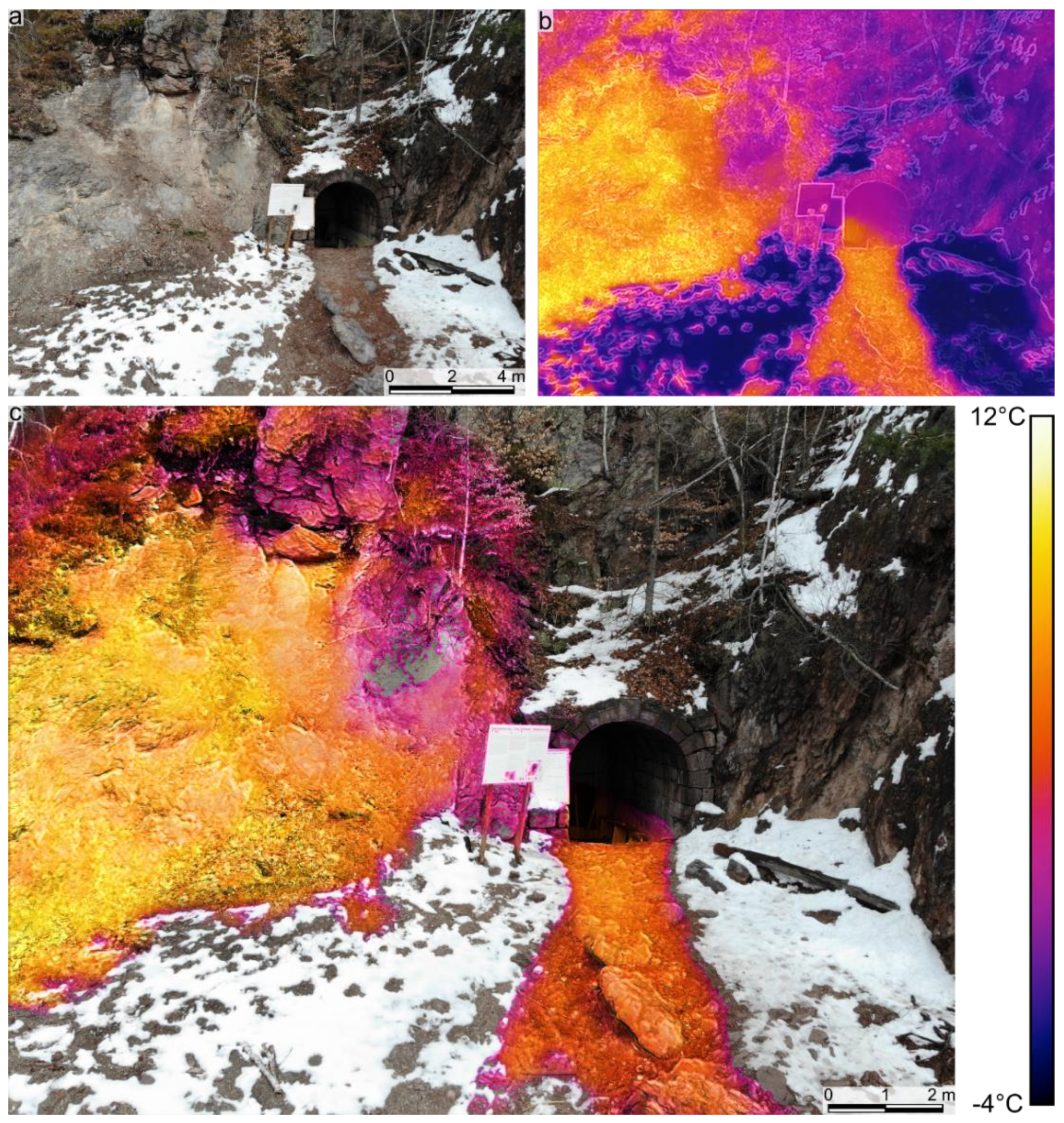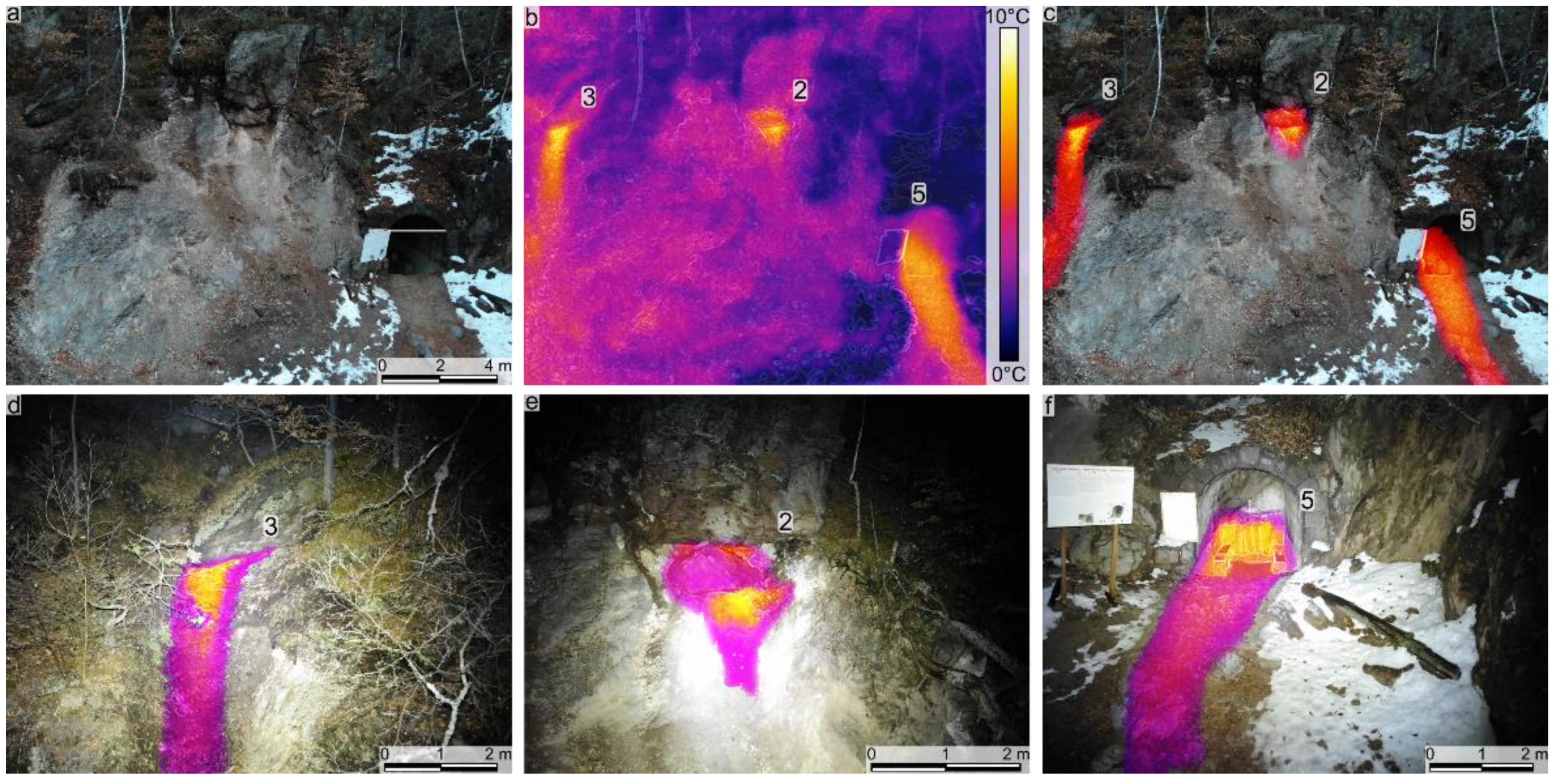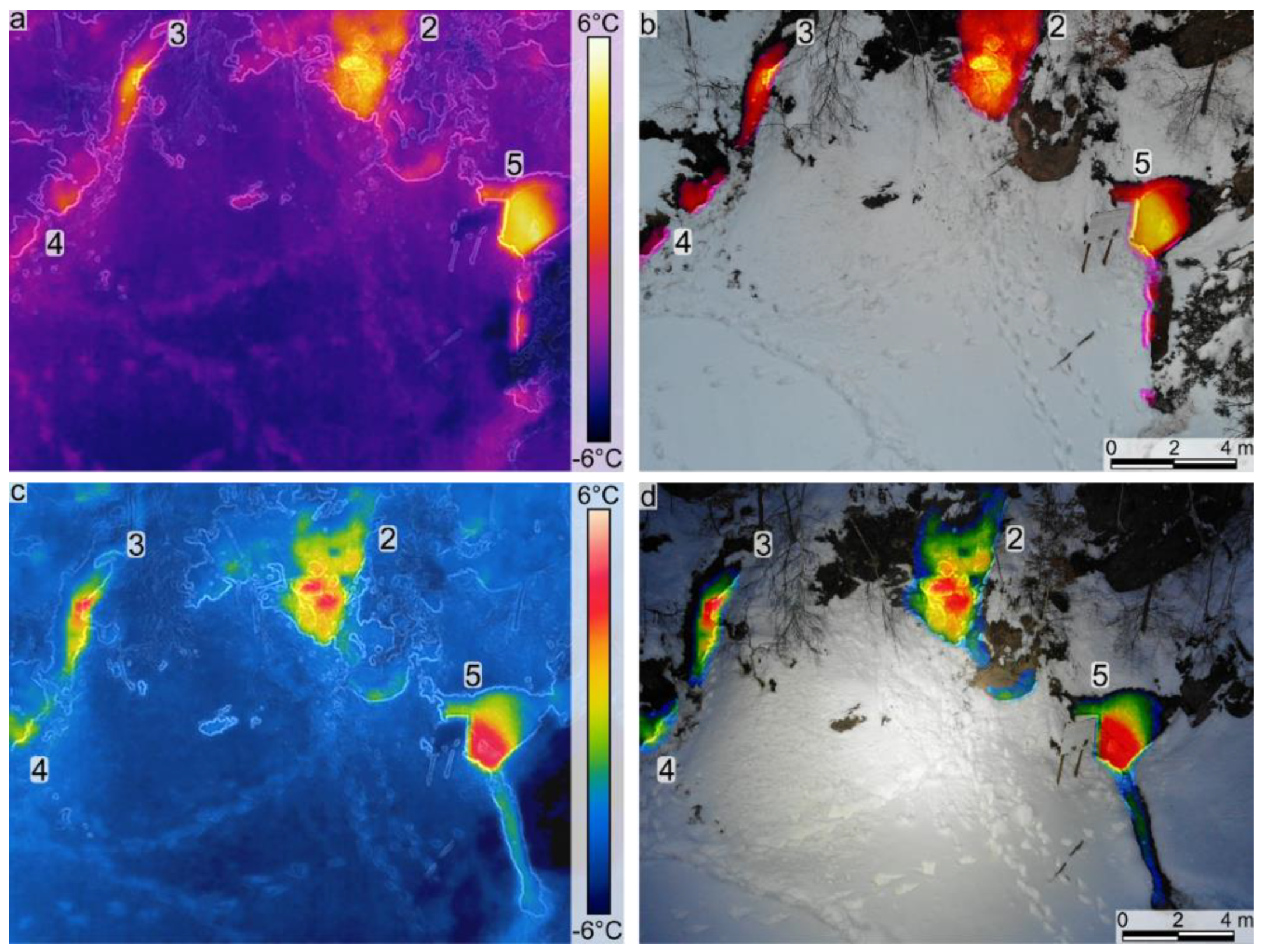Identifying CO2 Seeps in a Long-Dormant Volcanic Area Using Uncrewed Aerial Vehicle-Based Infrared Thermometry: A Qualitative Study
Abstract
1. Introduction
2. Geological Overview
3. Materials and Methods
3.1. UAV Data Acquisition
3.1.1. Technical Specifications of the UAV Cameras
3.1.2. Hardware Limitations
3.1.3. RGB and Infrared Thermometry Survey
3.2. 3D SfM Models
3.3. Measuring Gas Emissions
4. Results
4.1. Infrared Thermometry Surveys
4.1.1. IRT Survey 1
4.1.2. IRT Survey 2
4.1.3. IRT Surveys 3 and 4
4.2. Structure from Motion Models
4.3. Gas Measurements
5. Discussion
5.1. Thermal Anomalies in the IRT Surveys and SfM Models
5.2. Implications for the Study of Gas Emissions
5.3. Way Forward
6. Conclusions
Author Contributions
Funding
Institutional Review Board Statement
Data Availability Statement
Acknowledgments
Conflicts of Interest
References
- Antoine, R.; Baratoux, D.; Rabinowicz, M.; Fontaine, F.; Bachèlery, P.; Staudacher, T.; Saracco, G.; Finizola, A. Thermal Infrared Image Analysis of a Quiescent Cone on Piton de La Fournaise Volcano: Evidence of Convective Air Flow within an Unconsolidated Soil. J. Volcanol. Geotherm. Res. 2009, 183, 228–244. [Google Scholar] [CrossRef][Green Version]
- Furukawa, Y. Infrared Thermography of the Fumarole Area in the Active Crater of the Aso Volcano, Japan, Using a Consumer Digital Camera. J. Asian Earth Sci. 2010, 38, 283–288. [Google Scholar] [CrossRef]
- Spampinato, L.; Calvari, S.; Oppenheimer, C.; Boschi, E. Volcano Surveillance Using Infrared Cameras. Earth-Sci. Rev. 2011, 106, 63–91. [Google Scholar] [CrossRef]
- Peters, N.; Oppenheimer, C.; Kyle, P. Autonomous Thermal Camera System for Monitoring the Active Lava Lake at Erebus Volcano, Antarctica. Geosci. Instrum. Method. Data Syst. 2014, 3, 13–20. [Google Scholar] [CrossRef]
- Di Felice, F.; Mazzini, A.; Di Stefano, G.; Romeo, G. Drone High Resolution Infrared Imaging of the Lusi Mud Eruption. Mar. Pet. Geol. 2018, 90, 38–51. [Google Scholar] [CrossRef]
- Jordan, B.R. Collecting Field Data in Volcanic Landscapes Using Small UAS (SUAS)/Drones. J. Volcanol. Geotherm. Res. 2019, 385, 231–241. [Google Scholar] [CrossRef]
- Mineo, S.; Pappalardo, G. Rock Emissivity Measurement for Infrared Thermography Engineering Geological Applications. Appl. Sci. 2021, 11, 3773. [Google Scholar] [CrossRef]
- Guerin, A.; Jaboyedoff, M.; Collins, B.D.; Derron, M.-H.; Stock, G.M.; Matasci, B.; Boesiger, M.; Lefeuvre, C.; Podladchikov, Y.Y. Detection of Rock Bridges by Infrared Thermal Imaging and Modeling. Sci. Rep. 2019, 9, 13138. [Google Scholar] [CrossRef]
- Oppenheimer, C.M.M.; Rothery, D.A. Infrared Monitoring of Volcanoes by Satellite. J. Geol. Soc. 1991, 148, 563–569. [Google Scholar] [CrossRef]
- Todesco, M.; Chiodini, G.; Macedonio, G. Monitoring and Modelling Hydrothermal Fluid Emission at La Solfatara (Phlegrean Fields, Italy). An Interdisciplinary Approach to the Study of Diffuse Degassing. J. Volcanol. Geotherm. Res. 2003, 125, 57–79. [Google Scholar] [CrossRef]
- Patrick, M.; Dean, K.; Dehn, J. Active Mud Volcanism Observed with Landsat 7 ETM+. J. Volcanol. Geotherm. Res. 2004, 131, 307–320. [Google Scholar] [CrossRef]
- Lagios, E.; Vassilopoulou, S.; Sakkas, V.; Dietrich, V.; Damiata, B.N.; Ganas, A. Testing Satellite and Ground Thermal Imaging of Low-Temperature Fumarolic Fields: The Dormant Nisyros Volcano (Greece). ISPRS J. Photogramm. Remote Sens. 2007, 62, 447–460. [Google Scholar] [CrossRef]
- Silvestri, M.; Rabuffi, F.; Pisciotta, A.; Musacchio, M.; Diliberto, I.; Spinetti, C.; Lombardo, V.; Colini, L.; Buongiorno, M. Analysis of Thermal Anomalies in Volcanic Areas Using Multiscale and Multitemporal Monitoring: Vulcano Island Test Case. Remote Sens. 2019, 11, 134. [Google Scholar] [CrossRef]
- Amici, S.; Turci, M.; Giammanco, S.; Spampinato, L.; Giulietti, F. UAV Thermal Infrared Remote Sensing of an Italian Mud Volcano. Adv. Remote Sens. 2013, 2, 358–364. [Google Scholar] [CrossRef]
- Harvey, M.C.; Rowland, J.V.; Luketina, K.M. Drone with Thermal Infrared Camera Provides High Resolution Georeferenced Imagery of the Waikite Geothermal Area, New Zealand. J. Volcanol. Geotherm. Res. 2016, 325, 61–69. [Google Scholar] [CrossRef]
- Walter, T.R.; Jousset, P.; Allahbakhshi, M.; Witt, T.; Gudmundsson, M.T.; Hersir, G.P. Underwater and Drone Based Photogrammetry Reveals Structural Control at Geysir Geothermal Field in Iceland. J. Volcanol. Geotherm. Res. 2020, 391, 106282. [Google Scholar] [CrossRef]
- Terada, A.; Morita, Y.; Hashimoto, T.; Mori, T.; Ohba, T.; Yaguchi, M.; Kanda, W. Water Sampling Using a Drone at Yugama Crater Lake, Kusatsu-Shirane Volcano, Japan. Earth Planets Space 2018, 70, 64. [Google Scholar] [CrossRef]
- Nooralishahi, P.; López, F.; Maldague, X. A Drone-Enabled Approach for Gas Leak Detection Using Optical Flow Analysis. Appl. Sci. 2021, 11, 1412. [Google Scholar] [CrossRef]
- McCaffrey, K.J.W.; Jones, R.R.; Holdsworth, R.E.; Wilson, R.W.; Clegg, P.; Imber, J.; Holliman, N.; Trinks, I. Unlocking the Spatial Dimension: Digital Technologies and the Future of Geoscience Fieldwork. J. Geol. Soc. 2005, 162, 927–938. [Google Scholar] [CrossRef]
- Westoby, M.J.; Brasington, J.; Glasser, N.F.; Hambrey, M.J.; Reynolds, J.M. ‘Structure-from-Motion’ Photogrammetry: A Low-Cost, Effective Tool for Geoscience Applications. Geomorphology 2012, 179, 300–314. [Google Scholar] [CrossRef]
- Tamas, A.; Holdsworth, R.E.; Underhill, J.R.; Tamas, D.M.; Dempsey, E.D.; Hardman, K.; Bird, A.; McCarthy, D.; McCaffrey, K.J.W.; Selby, D. New Onshore Insights into the Role of Structural Inheritance during Mesozoic Opening of the Inner Moray Firth Basin, Scotland. J. Geol. Soc. 2022, 179, jgs2021-066. [Google Scholar] [CrossRef]
- Tamas, D.M.; Tamas, A.; Barabasch, J.; Rowan, M.; Schleder, Z.; Krézsek, C.; Urai, J. Low-Angle Shear within the Exposed Manzalesti Diapir, Romania: Salt Decapitation in the Eastern Carpathians Fold-and-Thrust Belt. Tectonics 2021, 40, e2021TC006850. [Google Scholar] [CrossRef]
- Althaus, T.; Niedermann, S.; Erzinger, J. Noble Gas Studies of Fluids and Gas Exhalations in the East Carpathians, Romania. Chem. Der Erde 2000, 60, 189–207. [Google Scholar]
- Vaselli, O.; Minissale, A.; Tassi, F.; Magro, G.; Seghedi, I.; Ioane, D.; Szakacs, A. A Geochemical Traverse across the Eastern Carpathians (Romania): Constraints on the Origin and Evolution of the Mineral Water and Gas Discharges. Chem. Geol. 2002, 182, 637–654. [Google Scholar] [CrossRef]
- Kis, B.-M.; Ionescu, A.; Cardellini, C.; Harangi, S.; Baciu, C.; Caracausi, A.; Viveiros, F. Quantification of Carbon Dioxide Emissions of Ciomadul, the Youngest Volcano of the Carpathian-Pannonian Region (Eastern-Central Europe, Romania). J. Volcanol. Geotherm. Res. 2017, 341, 119–130. [Google Scholar] [CrossRef]
- Kis, B.M.; Caracausi, A.; Palcsu, L.; Baciu, C.; Ionescu, A.; Futó, I.; Sciarra, A.; Harangi, S. Noble Gas and Carbon Isotope Systematics at the Seemingly Inactive Ciomadul Volcano (Eastern-Central Europe, Romania): Evidence for Volcanic Degassing. Geochem. Geophys. Geosyst. 2019, 20, 3019–3043. [Google Scholar] [CrossRef]
- Pricajan, A. Apele Minerale si Termale din Romania; Editura Tehnică: Bucharest, Romania, 1972. [Google Scholar]
- Berszán, J.C.J.; Jánosi, K.; Kristály, F.; Péter, E.; Szakáll, S.; Ütő, G. The Mineral Waters of Szeklerland; Tipographic: Miercurea Ciuc, Romania, 2009. [Google Scholar]
- Harangi, S.; Downes, H.; Seghedi, I. Tertiary-Quaternary Subduction Processes and Related Magmatism in the Alpine-Mediterranean Region. Geol. Soc. Lond. Mem. 2006, 32, 167–190. [Google Scholar] [CrossRef]
- Szakács, A.; Seghedi, I. The Călimani–Gurghiu–Harghita Volcanic Chain, East Carpathians, Romania: Volcanological Features. Acta Volcanol. 1995, 7, 145–153. [Google Scholar]
- Szakacs, A.; Seghedi, I.; Pécskay, Z. Pecularities of South Harghita Mts. as Terminal Segment of the Carpathian Neogene to Quaternary Volcanic Chain. Rev. Roum. Géol. 1993, 37, 21–36. [Google Scholar]
- Harangi, S.; Lukács, R.; Schmitt, A.K.; Dunkl, I.; Molnár, K.; Kiss, B.; Seghedi, I.; Novothny, Á.; Molnár, M. Constraints on the Timing of Quaternary Volcanism and Duration of Magma Residence at Ciomadul Volcano, East–Central Europe, from Combined U–Th/He and U–Th Zircon Geochronology. J. Volcanol. Geotherm. Res. 2015, 301, 66–80. [Google Scholar] [CrossRef]
- Szakács, A.; Seghedi, I.; Pécskay, Z.; Mirea, V. Eruptive History of a Low-Frequency and Low-Output Rate Pleistocene Volcano, Ciomadul, South Harghita Mts., Romania. Bull Volcanol 2015, 77, 12. [Google Scholar] [CrossRef]
- Matenco, L.; Bertotti, G. Tertiary Tectonic Evolution of the External East Carpathians (Romania). Tectonophysics 2000, 316, 255–286. [Google Scholar] [CrossRef]
- Cloetingh, S.A.P.L.; Burov, E.; Matenco, L.; Toussaint, G.; Bertotti, G.; Andriessen, P.A.M.; Wortel, M.J.R.; Spakman, W. Thermo-Mechanical Controls on the Mode of Continental Collision in the SE Carpathians (Romania). Earth Planet. Sci. Lett. 2004, 218, 57–76. [Google Scholar] [CrossRef]
- Seghedi, I.; Downes, H.; Szakács, A.; Mason, P.R.D.; Thirlwall, M.F.; Roşu, E.; Pécskay, Z.; Márton, E.; Panaiotu, C. Neogene–Quaternary Magmatism and Geodynamics in the Carpathian–Pannonian Region: A Synthesis. Lithos 2004, 72, 117–146. [Google Scholar] [CrossRef]
- Nicolaescu, V. Contributions to the knowledge on the Cretaceous flysch of the western part of Bodoc Mts. Stud. Cercet. Geol. Geofiz. Geogr. 1973, 18, 479–488. [Google Scholar]
- Săndulescu, M. Geotectonica României; Editura Tehnică: Bucharest, Romania, 1984. [Google Scholar]
- Grasu, C.; Catana, C.; Bobos, I. Petrology of the Flysch Formations in the Inner Carpathians; Editura Tehnică: Bucharest, Romania, 1996. [Google Scholar]
- Molnár, K.; Harangi, S.; Lukács, R.; Dunkl, I.; Schmitt, A.K.; Kiss, B.; Garamhegyi, T.; Seghedi, I. The Onset of the Volcanism in the Ciomadul Volcanic Dome Complex (Eastern Carpathians): Eruption Chronology and Magma Type Variation. J. Volcanol. Geotherm. Res. 2018, 354, 39–56. [Google Scholar] [CrossRef]
- Molnár, K.; Lukács, R.; Dunkl, I.; Schmitt, A.K.; Kiss, B.; Seghedi, I.; Szepesi, J.; Harangi, S. Episodes of Dormancy and Eruption of the Late Pleistocene Ciomadul Volcanic Complex (Eastern Carpathians, Romania) Constrained by Zircon Geochronology. J. Volcanol. Geotherm. Res. 2019, 373, 133–147. [Google Scholar] [CrossRef]
- Ilosvay, L. A Torjai Büdösbarlang Levegőjének Chemiai És Fizikai Vizsgálata. (The Chemical and Physical Analysis of the Torjai Stinky Cave). K. Magy. Term. Tud. Társ. 1895. Available online: https://www.arcanum.com/hu/online-kiadvanyok/MuMaTu-a-mult-magyar-tudosai-1/ilosvay-lajos-29F4/tudomanyos-es-ismeretterjeszto-tevekenysege-2A90/a-torjai-budos-barlang-levegojenek-vizsgalata-2AA3/ (accessed on 1 February 2022).
- Agisoft LLC. Agisoft Metashape Professional. 2022. Available online: https://www.agisoft.com/ (accessed on 1 February 2022).
- Aiuppa, A. Chemical Mapping of a Fumarolic Field: La Fossa Crater, Vulcano Island (Aeolian Islands, Italy). Geophys. Res. Lett. 2005, 32, L13309. [Google Scholar] [CrossRef]
- Shinohara, H. A New Technique to Estimate Volcanic Gas Composition: Plume Measurements with a Portable Multi-Sensor System. J. Volcanol. Geotherm. Res. 2005, 143, 319–333. [Google Scholar] [CrossRef]
- Gålfalk, M.; Nilsson Påledal, S.; Bastviken, D. Sensitive Drone Mapping of Methane Emissions without the Need for Supplementary Ground-Based Measurements. ACS Earth Space Chem. 2021, 5, 2668–2676. [Google Scholar] [CrossRef]
- Stix, J.; de Moor, J.M.; Rüdiger, J.; Alan, A.; Corrales, E.; D’Arcy, F.; Diaz, J.A.; Liotta, M. Using Drones and Miniaturized Instrumentation to Study Degassing at Turrialba and Masaya Volcanoes, Central America. J. Geophys. Res. Solid Earth 2018, 123, 6501–6520. [Google Scholar] [CrossRef]





| Campaign No. | IRT Survey No. | Acquisition Time (GMT + 2) | Air Temp. (°C) | Thermal Palette | Temp. Scale (°C) | No. of Photographs |
|---|---|---|---|---|---|---|
| 1 | 1 | 13:00 | 6 | HotMetal | −4–12 | 329 |
| 1 | 2 | 18:30 | −2 | HotMetal | 0–10 | 181 |
| 2 | 3 | 18:30 | −3 | HotMetal | −6–6 | 360 |
| 2 | 4 | 19:00 | −4 | Rainbow | −6–6 | 289 |
| ID | Site | Date | Longitude | Latitude | H2S (ppm) | CH4(%) | CO2(%) |
|---|---|---|---|---|---|---|---|
| 1 | Dry gas emission 1 | 21 March 2021 | 25.948388 | 46.119762 | 166.32 | 4.08 | 94.57 |
| 23 August 2021 | 164.84 | 3.67 | 97.8 | ||||
| 2 | Dry gas emission 2 | 21 March 2021 | 25.94855 | 46.11986 | 164.92 | 3.85 | 97.46 |
| 3 | Dry gas emission 3 | 21 March 2021 | 25.94846 | 46.11982 | 127.6 | 3.42 | 93.66 |
| 23 August 2021 | 67.14 | 3.05 | 91.25 | ||||
| 4 | Dry gas emission 4 | 21 March 2021 | 25.94843 | 46.11978 | 165.26 | 3.06 | 78.65 |
| 23 August 2021 | 164.83 | 3.64 | 95.79 | ||||
| 5 | Stinky Cave | 21 March 2021 | 25.94867 | 46.11980 | 164.91 | 3.62 | 96.63 |
| 23 August 2021 | 164.89 | 3.65 | 97.59 |
Publisher’s Note: MDPI stays neutral with regard to jurisdictional claims in published maps and institutional affiliations. |
© 2022 by the authors. Licensee MDPI, Basel, Switzerland. This article is an open access article distributed under the terms and conditions of the Creative Commons Attribution (CC BY) license (https://creativecommons.org/licenses/by/4.0/).
Share and Cite
Tămaș, D.M.; Kis, B.M.; Tămaș, A.; Szalay, R. Identifying CO2 Seeps in a Long-Dormant Volcanic Area Using Uncrewed Aerial Vehicle-Based Infrared Thermometry: A Qualitative Study. Sensors 2022, 22, 2719. https://doi.org/10.3390/s22072719
Tămaș DM, Kis BM, Tămaș A, Szalay R. Identifying CO2 Seeps in a Long-Dormant Volcanic Area Using Uncrewed Aerial Vehicle-Based Infrared Thermometry: A Qualitative Study. Sensors. 2022; 22(7):2719. https://doi.org/10.3390/s22072719
Chicago/Turabian StyleTămaș, Dan Mircea, Boglárka Mercédesz Kis, Alexandra Tămaș, and Roland Szalay. 2022. "Identifying CO2 Seeps in a Long-Dormant Volcanic Area Using Uncrewed Aerial Vehicle-Based Infrared Thermometry: A Qualitative Study" Sensors 22, no. 7: 2719. https://doi.org/10.3390/s22072719
APA StyleTămaș, D. M., Kis, B. M., Tămaș, A., & Szalay, R. (2022). Identifying CO2 Seeps in a Long-Dormant Volcanic Area Using Uncrewed Aerial Vehicle-Based Infrared Thermometry: A Qualitative Study. Sensors, 22(7), 2719. https://doi.org/10.3390/s22072719







